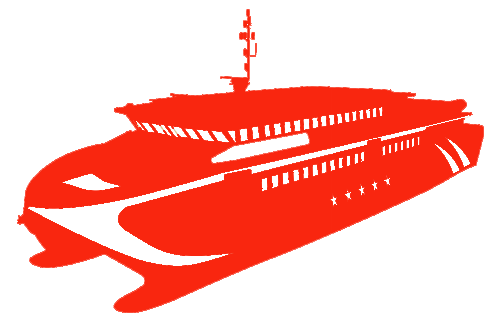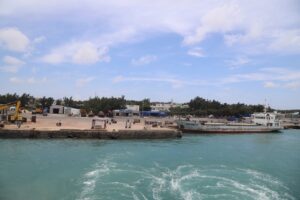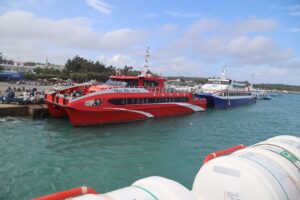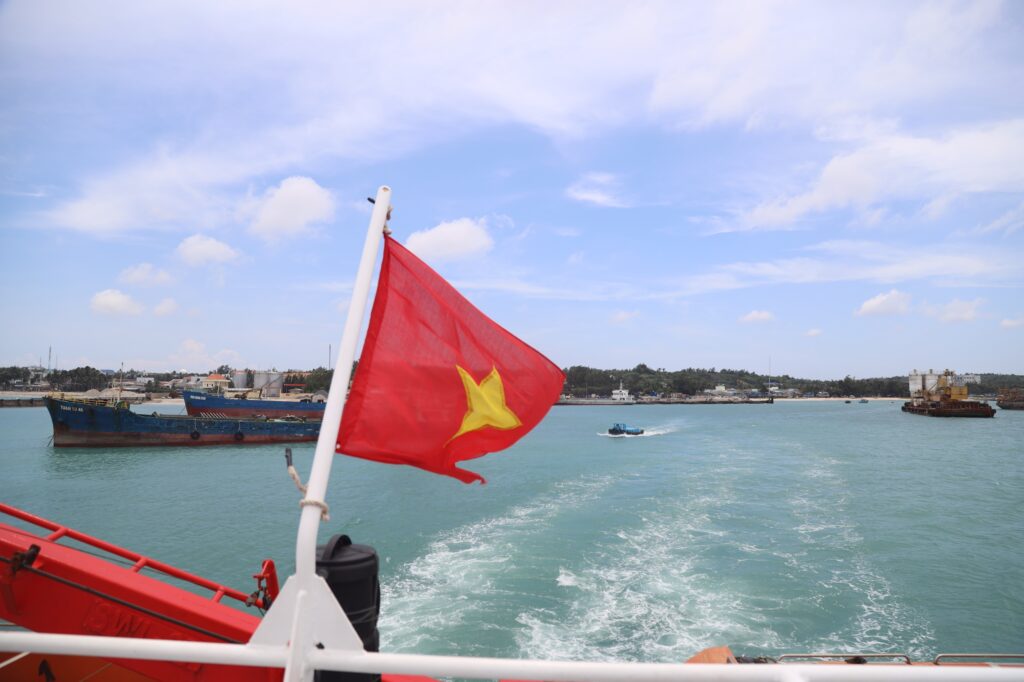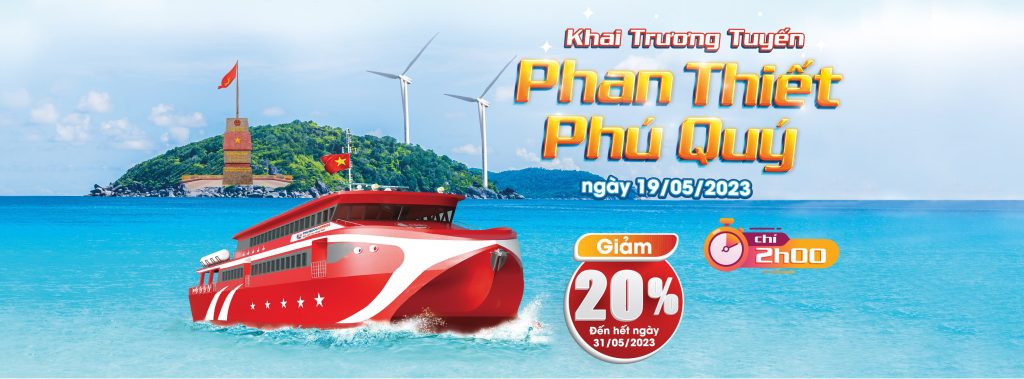An Thanh temple is located in Trieu Duong village, Tam Thanh commune, Phu Quy district; about 2.5km southeast of Phu Quy district center and 800m east of People’s Committee of Tam Thanh Commune. An Thanh temple was ranked a national monument by the Ministry of Culture and Information (now the Ministry of Culture, Sports and Tourism) in 1996.
The relic was called An Thanh temple by the people of Phu Quy island and meant to express the wish to have a peaceful and prosperous life for the community. This place worship whales (“Grandfather” fish), that is a god or a god Nam Hai associated with the fishing beliefs of fishermen in the Central coast of our country.
In the 17th and 18th centuries, a large part of Ngu Quang people in turn went to the south to explore and create a new life and a part of them stopped settling in Phu Quy island. In which, the faith of “Grandfather” fish worship is brought from the native land to the new land to make spiritual support for a new living environment among four vast, dangerous oceans that always lurk with them during their trips to exploit and caught seafood.
Phu Quy fishermen always have a strong belief in the miracle of “Grandfather” fish and worship him as a relief god by his side in dangerous sea trips. There are many stories about the holiness of the god Nam Hai, although they are just some more or less legendary, but for fishermen, they absolutely believe and worship them solemnly.
An Thanh temple was built in the year of the Ox (1781), is the temple with the earliest era compared to the other ones in Phu Quy. In addition to the main function of worshiping God Nam Hai, also serving to worship the village’s Thanh Hoang and Tien Hien, and Hau Hien who are the forbears with many merits in exploring and creating the village and temple.
In the year of the Ox (1841), a “Grandfather” fish was entangled (died) drifted on ashore in front of the temple, this is a miracle for fishermen, they immediately put “Grandfather” into burial next to the temple and hold solemn rituals according to the custom. After 3 years, this Grandfather fish’s skeleton was worshiped by fishermen and brought to the mausoleum for worship. Because this is the first “Grandfather” fish that drifted on the island, the fishermen are honored as “Great grandfather”. Currently, on the edicule of God Nam Hai in the temple, there is still a mantra of worshiping “Great grandfather” engraved with Han Nom characters “Nam Te Hai linh cu toc Ngoc Lan thuy tuong ton Than, Tan Suu nien, thap ngoat thap ngu nhat ti thoi”.
Coming to An Thanh temple, visitors will be contemplated with folk architectural items that are both imprinted with the architectural mark of faith institutions in the Central and bring the unique characteristics of Phu Quy island associated with “Grandfather” fish worship beliefs such as: Great Hall, Vo ca and Tien Hien that are arranged like no. 3 in Chinese characters.The main direction of the temple turns south and looks straight out to the sea. The Great Hall is built in the architecture of “four pillars” with 4 main wooden pillars in the bearing center and connected with trusses and sub-forepoling around to form a solid frame supporting the roof top. The Great Hall is divided into 3 compartments, in the front center is the place to worship god Nam Hai and the back is the worshiping of “Grandfather” fish’s bones; Tien Su altar and Mrs Thuy Long altar located in the left and right compartments of god Nam Hai altar. The Tien Hien Church is located adjacent to the back of the Great Hall. The Vo ca church connects to the front of the Great hall, where the rituals, folk festivals, cultural activities and entertainment of fishermen take place.
Inside the interior, architectural items of An Thanh temple are decorated, preserved many ancient texts in Han Nom characters inscribed on the horizontal lacquered board, parallel sentences and many ancient stories associated with the fishing beliefs to praises the merits of the Sea Gods and the seniors who established villages and built the temple; has the meaning of educating and directing people to the origin, the fine cultural traditions of the nation.
The burial area of “Grandfather” fish’s corpse: It is arranged in the left area of the temple, according to ancient custom, when catching seafood discovers “Grandfather” fish drifting in the sea, fishermen will stop the trip to bring “Grandfather” fish to the shore, the temple will conduct a very solemn ceremony and then bury “Grandfather” fish in the temple.
After 24 months for a small and medium “Grandfather” fish, 36 months for a big “Grandfather” fish; fishermen will conduct the ritual to take the ashes of “Grandfather” fish and put them in the Great hall to worship.
In addition to the values of traditional folk architecture, An Thanh temple also preserves 10 honours of the kings of Tu Duc, Dong Khanh and Duy Tan as an expression of the power of spiritual culture on the island.
An Thanh temple is considered as a marine culture museum with many collections associated with the characteristic of “Grandfather” fish worship beliefs, where kept more than 70 skeletons of all kinds of whales, dermochelys coriacea and dugong (sea cows) are worshiped by fishermen with respectful and solemn rituals.
Currently, the temple are displaying the sperm whale’s skeleton of the toothed whale family; the skeleton is over 17 mn long, 50 vertebras including 37 original ones and 13 restored ones; 30 pairs of teeth erupted in lower jaw, no teeth in upper jaw.
According to scientists, the sperm whale has a very large head, accounting for 1/3 of the body length; the body is 20 m long, the male weighs about 70 tons, the female weighs 30 tons; maxillary cavity of the cellulite is very large, lower jaw is long and narrow, no teeth in upper jaw. Males are very aggressive, they eat large fish, squid, while protecting the female and child, they can attack both humans and boats.
Every year at An Thanh temple, there are 2 festivals: Te Xuan Festival and Te Thu festival (combined with the death anniversary of “Great grandfather”) Te Xuan festival: takes place during the period from the 10th to 20th of the first lunar month, this is also the fishermen festival New Year of the temple to pray for the nation’s peace, timely rains and favourable weather, abundant crops…
In addition to the rituals of traditional customs, the festival also has cultural activities, entertainment, attracting a large number of island fishermen. This is an opportunity to educate people about the origins, ancestors and the traditional values of the nation.
Te Thu festival (combined with the death anniversary of “Great grandfather”): After the first “Grandfather” fish was bured by fishermen at the temple in 1841, since then, An Thanh temple took October 15th Lunar Calendar every year is the dead anniversary of “Great grandfather” and this is also Te Thu festival of the temple. In addition to the solemn rituals similar to the Te Xuan Festival, the temple festival also organizes the ceremony of welcoming Mr. Sanh from the sea, fishermen organize boats, incense-table, flags and drums to go to sea to welcome the living Sea Gods to the temple of witnesses to sacrifice.
During the festival in An Thanh temple, types of folk arts such as ceremonial folk songs, ‘Cheo’ singing… are very unique traditional tunes of Phu Quy fishermen performed to attract fishermen’s sections to participate in performances and enjoy. On these occasions, islanders who work far away from anywhere are eager to return, ready to generously contribute money for the festival to be more complete, more beautiful and more fun. The Fishermen Festival is an opportunity to bond the members of the village together, is a place to gather the idea of devotion and gratitude to the Sea Gods and seniors with meritorious services to the village associated with the ethic “When you drink water, remember the source” in the traditional culture of the Vietnamese people.
Coming to An Thanh temple on Phu Quy island, visitors will learn more about the customs and beliefs of “Grandfather” fish worshiping on the island, as well as the cultural values of the islands shown in the worship space, the traditional festivals have been transmited and preserved by fishermen for many generations. Thereby, it helps us to understand an important part of the history of the formation and development of Phu Quy island and the unique beliefs associated with the livelihood environment of fishermen here


